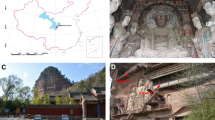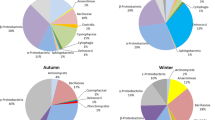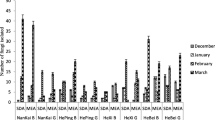Abstract
Monitoring dynamics of airborne fungal species and controlling of harmful ones are of vital importance to conservation of cultural relics. However, the evaluation of air quality and the community structure characteristics of microorganisms, especially fungi, in the atmosphere of archives is in a stage of continuous exploration though more than 4,000 archives were constructed in China. Seventy-two air samples were collected in this study under different spatial and weather conditions from the archives of Kunming Medical University, located in the Kunming metropolitan area, Yunnan province, southwestern China. A total of 22 airborne fungal classes, 160 genera and 699 ASVs were identified, the species diversity is on the rise with the strengthening of air circulation with the outside space, and thus the intensive energy metabolism and activity were found in the spaces with window and sunny weather, except for the higher lipid synthesis of indoor samples than that of outdoor ones. Furthermore, there were significant differences in fungal community composition and abundance between sunny and rainy weathers. A considerable number of species have been identified as indicator in various environmental and weather conditions of the archives, and temperature and humidity were thought to have significant correlations with the abundance of these species. Meanwhile, Cladosporium and Alternaria were the dominant genera here, which may pose a threat to the health of archive professionals. Therefore, monitoring and controlling the growth of these fungal species is crucial for both conservation of paper records and health of archive professionals.








Similar content being viewed by others
References
Cabral JP (2010) Can we use indoor fungi as bioindicators of indoor air quality? Historical perspectives and open questions. Sci Total Environ 408:4285–4295
Cappitelli F, Pasquariello G, Tarsitani G, Sorlini C (2010) Scripta manent? Assessing microbial risk to paper heritage. Trends Microbiol 18:538–542
Tang H, Jiang J, Fan WQ, Wang C (2015) Investigation of air microorganism contamination in museum storeroom. Occup Health 31:2088–2092
Borrego S, Lavin P, Perdomo I, Gomez de Saravia S, Guiamet P (2012) Determination of indoor air quality in archives and biodeterioration of the documentary heritage. ISRN Microbiol 2012: 680598
Guiamet P, Borrego S, Lavin P, Perdomo I, de Saravia SG (2011) Biofouling and biodeterioration in materials stored at the historical archive of the Museum of La Plata, Argentine and at the National Archive of the Republic of Cuba. Colloids Surf B 85:229–234
Ren SS (2018) Research progress on microbial species in domestic libraries, archives, and museums. Res Prot Anc Books 172–178
Grinshpun SA, Reponen TWilleke K (1997) Aerosol characteristics of airborne actinomycetes and fungi. J Aerosol Sci 28:667–668
Duan DC (2017) The Study on the protection of paper relics by bacterial cellulose and chitinous; Master thesis, Liaoning University, Shenyang, China
Borrego S, Guiamet P, Gómez de Saravia S, Batistini P, Garcia M, Lavin P, Perdomo I (2010) The quality of air at archives and the biodeterioration of photographs. Int Biodeterior Biodegrad 64:139–145
Li GH, Song SL, Li XZ, Jiang JX, Cao BL (2014) Detrimental Fungi types in Paper Files in Jiangxi Province. Biol Disaster Sci 37:301–304
Silva M, Moraes A, Nishikawa MM, Gatti M, Alencar M, BrandO LE, Nóbrega A (2006) Inactivation of fungi from deteriorated paper materials by radiation. Int Biodeterior Biodegrad 57:163–167
Pinzari F, De Mico GPA (2006) Biodeterioration of paper: a SEM study of fungal spoilage reproduced under controlled conditions. Macromol Symp 238:57–66
Kumar P, Singh AB, Singh R (2022) Comprehensive health risk assessment of microbial indoor air quality in microenvironments. PLoS ONE 17:e0264226
Estensmo ELF, Smebye Botnen S, Maurice S, Martin-Sanchez PM, Morgado L, Bjorvand Engh I, Hoiland K, Skrede I, Kauserud H (2022) The indoor mycobiomes of Daycare centers are affected by occupancy and climate. Appl Environ Microbiol 88:e0211321
Felgueiras F, Mourao Z, Oliveira Fernandes E, Gabriel MF (2022) Airborne bacterial and fungal concentrations and fungal diversity in bedrooms of infant twins under 1 year of age living in Porto. Environ Res 206:112568
An XL, Xu JX, Xu MR, Zhao CX, Li H, Zhu YG, Su JQ (2023) Dynamics of Microbial Community and potential Microbial pollutants in Shopping malls. mSystems 8:e0057622
Wang DQ (2020) How to protect paper archives in archives. Inside Outside Lantai 81–82
Ma MS (2020) Research on the preservation and methods of Paper archives in Public Security organs. Office Oper 117–119
Rai S, Singh DK, Kumar A (2021) Microbial, environmental and anthropogenic factors influencing the indoor microbiome of the built environment. J Basic Microbiol 61:267–292
Shin SK, Kim J, Ha SM, Oh HS, Chun J, Sohn J, Yi H (2015) Metagenomic insights into the bioaerosols in the indoor and outdoor environments of childcare facilities. PLoS ONE 10:e0126960
Kotay S, Chai W, Guilford W, Barry K, Mathers AJ (2017) Spread from the Sink to the patient: in situ study using Green fluorescent protein (GFP)-Expressing Escherichia coli to Model bacterial dispersion from hand-washing Sink-Trap reservoirs. Appl Environ Microbiol 83:e0332716
Haas D, Habib J, Galler H, Buzina W, Schlacher R, Marth E, Reinthaler FF (2007) Assessment of indoor air in Austrian apartments with and without visible mold growth. Atmos Environ 41:5192–5201
Bamba I, Azuma M, Hamada N, Kubo H, Isoda N (2014) Case study of airborne fungi according to air temperature and relative humidity in houses with semi-basements adjacent to a forested hillside. Biocontrol Sci 19:1–9
Peng N, Zhou H, Li JL, Wang YM, Li YX (2015) Study on the variation characteristic and future Trend of Urbanization Cimate in Kunming in nearly fifty years. J Anhui Agric Sci 43:171–174
Zhuang YF, Xie KM, He YZ (2017) A study on the adaptability of the climate in Kunming region to the development of olive oil. Agric Technol 37:152–153
Zhang J, Kobert K, Flouri T, Stamatakis A (2014) PEAR: a fast and accurate Illumina paired-end reAd mergeR. Bioinformatics 30:614–620
Pertea G (2015) fqtrim: v0.9.4 release
Rognes T, Flouri T, Nichols B, Quince C, Mahé F (2016) VSEARCH: a versatile open source tool for metagenomics. PeerJ 4
Bolyen E, Rideout JR, Dillon MR, Bokulich NA, Abnet CC, Al-Ghalith GA, Alexander H, Alm EJ, Arumugam M, Asnicar F et al (2019) Reproducible, interactive, scalable and extensible microbiome data science using QIIME 2. Nat Biotechnol 37:852–857
Nilsson RH, Larsson K-H, Taylor AFS, Bengtsson-Palme J, Jeppesen TS, Schigel D, Kennedy P, Picard K, Glöckner FO, Tedersoo L, Saar I, Kõljalg U, Abarenkov K (2019) The UNITE database for molecular identification of fungi: handling dark taxa and parallel taxonomic classifications. Nucleic Acids Res 47:D259–D264
Maidak BL, Olsen GJ, Larsen N, Overbeek R, McCaughey MJ, Woese CR (1997) The RDP (ribosomal database project). Nucleic Acids Res 25:109–110
Douglas GM, Maffei VJ, Zaneveld JR, Yurgel SN, Brown JR, Taylor CM, Huttenhower C, Langille MGI (2020) PICRUSt2 for prediction of metagenome functions. Nat Biotechnol 38:685–688
Kanehisa M (2000) KEGG: Kyoto Encyclopedia of genes and genomes. Nucleic Acids Res 28:27–30
Galperin MY, Wolf YI, Makarova KS, Vera Alvarez R, Landsman D, Koonin EV (2021) COG database update: focus on microbial diversity, model organisms, and widespread pathogens. Nucleic Acids Res 49:D274–D281
Chueachavalit C, Meephansan J, Payungporn S, Sawaswong V, Chanchaem P, Wongpiyabovorn J, Thio HB (2022) Comparison of Malassezia spp. colonization between human skin exposed to high- and low-ambient air pollution. Exp Dermatol 31:1454–1461
Ye J (2021) Study on Residential Microbial Communities in Nanjing Based on High-Throughput Sequencing and Culturing Methods; Doctoral dissertation, Southeast University, NanJing, China
Ziaee A, Zia M, Goli M (2018) Identification of saprophytic and allergenic fungi in indoor and outdoor environments. Environ Monit Assess 190:574
Adams RI, Miletto M, Taylor JW, Bruns TD (2013) Dispersal in microbes: fungi in indoor air are dominated by outdoor air and show dispersal limitation at short distances. ISME J 7:1262–1273
Fang ZG, Ouyang ZY (2009) Advance of airborne fungal community and the influencing factors in indoor and outdoor environments in urban ecosystem. Ecol Environ Sci 18:386–393
Fu CL, He WH, Jia JH, Sun ZM, Yuan W, Zhou YG, Yan EP (2000) Special investgation of Fungi from Four cities of China. Microbiol China 264–269
Fang ZG, Ouyang ZY, Hu LF, Wang XK, Lin XQ (2005) Community structure and ecological distribution of airborne microbes in summer in Beijin. Acta Ecol Sin 83–88
Chang CW, Chung H, Huang CF, Su HJ (2001) Exposure of workers to airborne microorganisms in open-air swine houses. Appl Environ Microbiol 67:155–161
Shelton BG, Kirkland KH, Flanders WD, Morris GK (2002) Profiles of airborne fungi in buildings and outdoor environments in the United States. Appl Environ Microbiol 68:1743–1753
Rejc T, Kukec A, Bizjak M, GodicTorkar K (2020) Microbiological and chemical quality of indoor air in kindergartens in Slovenia. Int J Environ Health Res 30:49–62
Li X (2013) Review of morphology classification of Cladosporium. J Anhui Agric Sci 41:6254–6255
Ma R, Huang H, Bai Y, Luo H, Fan Y, Yao B (2018) Insight into the cold adaptation and hemicellulose utilization of Cladosporium neopsychrotolerans from genome analysis and biochemical characterization. Sci Rep 8:6075
Ren P, Ahearn DG, Crow SA (1998) Mycotoxins of Alternaria alternata produced on ceiling tiles. J Ind Microbiol Biotechnol 20:53–54
Xie HY (2006) Studies on investigation and morphologic and moleculai identification of the genus Alternaria Nees from some areas of China; Master thesis, Guizhou University, Guizhou, China
Grewling L, Nowak M, Szymanska A, Kostecki L, Bogawski P (2019) Temporal variability in the allergenicity of airborne Alternaria spores. Med Mycol 57:403–411
Macris BJ (1984) Production and characterization of cellulase and beta-glucosidase from a mutant of Alternaria alternata. Appl Environ Microbiol 47:560–565
Robl D, Delabona Pda S, Mergel CM, Rojas JD, Costa Pdos S, Pimentel IC, Vicente VA, da Pradella C, Padilla JG G (2013) The capability of endophytic fungi for production of hemicellulases and related enzymes. BMC Biotechnol 13:94
Zhou YH, Zhang CY (2021) Research Progress on Cellulase produced by Aspergillus Niger. Agricultural Technology & Equipment, pp 72–73
Li T (2019) Comparison of basic culture characteristics of different Aspergillus oryzae strains and heterology experession of lipase; Master thesis, Nanchang University, Nanchang, China
Fan LX (2022) Screening of Aspergillus oryzae with High Protease Activity and its Application in Doubanjiang; Master thesis, Jiangnan University, Wuxi, China
Zhang S, Qu QS, Cheng H (2018) Amylase production from solid-state fermentation of kitchen garbage by aspergillus oryzae. China Food Addit 141–146
Zhang X, Han SY (2016) Research Progress on Fermentation production of enzyme by Aspergillus Niger. Chem Bioeng (Wuhan China) 33:13–16
Simonovicova A, Hlinkova E, Chovanova K, Pangallo D (2013) Influence of the Environment on the morphological and biochemical characteristics of different aspergillus Niger Wild type strains. Indian J Microbiol 53:187–193
Pinheiro AC, Sequeira SO, Macedo MF (2019) Fungi in archives, libraries, and museums: a review on paper conservation and human health. Crit Rev Microbiol 45:686–700
Chen YP, Cui Y, Dong JG (2010) Variation of airborne bacteria and fungi at Emperor Qin’s Terra-Cotta Museum, Xi’an, China, during the Oct. 1 gold week period of 2006. Environ Sci Pollut Res Int 17:478–485
Tian ZL, Long K, YI XH, Ren SS, Zhang M (2016) A study on influence of storage environment on paper properties. China Pulp Pap Ind 37:31–33
Li XL, Tu XY, Deng F (2010) Discussion on anti mold measures in paper archives preservation. Light Ind Sci Technol 26:5–6
Funding
This research was jointly funded by the Department of Science and Technology of Yunnan Province (202101AY070001-072) to YW and National Natural Science Foundation of China (32270018) to YZ.
Author information
Authors and Affiliations
Contributions
Conceptualization, Y.Z. and Y.W.; methodology, Q.Z., L.Z., Y. H., L.Y.; software, Q.Z., L.Z. and Y. H.; validation, Y.Z., Y.W., Q.Z. and L.Z.; formal analysis, Q.Z., L.Z. and Y. H.; investigation, Y. H., L.Y. and Q. X. Z.; resources, Y. H., L.Y. and Q. X. Z.; data curation, Q.Z., L.Z., Y. H. and L.Y.; writing—original draft preparation, Q.Z. and L.Z.; writing—review and editing, Y.Z., Y.W., Q.Z. and L.Z.; visualization, Y.Z., Y.W., Q.Z. and L.Z.; supervision, Y.Z. and Y.W.; project administration, Y.Z. and Y.W.; funding acquisition, Y.Z. and Y.W. All authors have read and agreed to the published version of the manuscript.
Corresponding authors
Ethics declarations
Conflict of interest
On behalf of all authors, the corresponding author states that there is no conflict of interest.
Additional information
Responsible Editor: Melissa Fontes Landell.
Publisher’s Note
Springer Nature remains neutral with regard to jurisdictional claims in published maps and institutional affiliations.
Rights and permissions
Springer Nature or its licensor (e.g. a society or other partner) holds exclusive rights to this article under a publishing agreement with the author(s) or other rightsholder(s); author self-archiving of the accepted manuscript version of this article is solely governed by the terms of such publishing agreement and applicable law.
About this article
Cite this article
Zhang, Q., Wang, Y., Hou, Y. et al. Metabarcode insights into the airborne fungal diversity in the indoor and outdoor environments in archives from Yunnan, Southwestern China. Braz J Microbiol (2024). https://doi.org/10.1007/s42770-024-01323-z
Received:
Accepted:
Published:
DOI: https://doi.org/10.1007/s42770-024-01323-z




